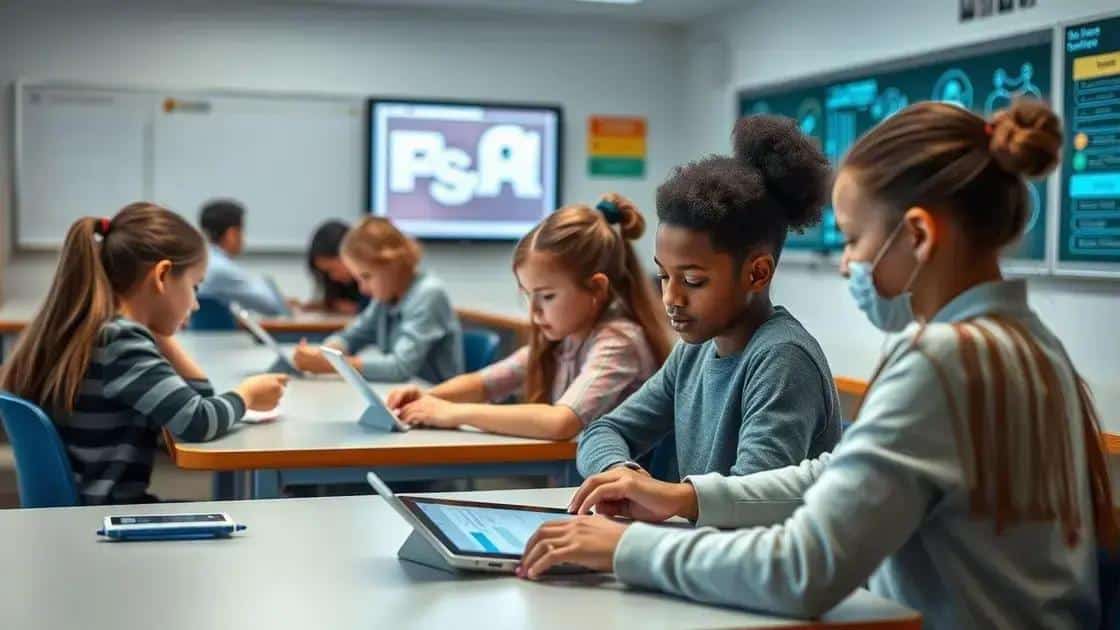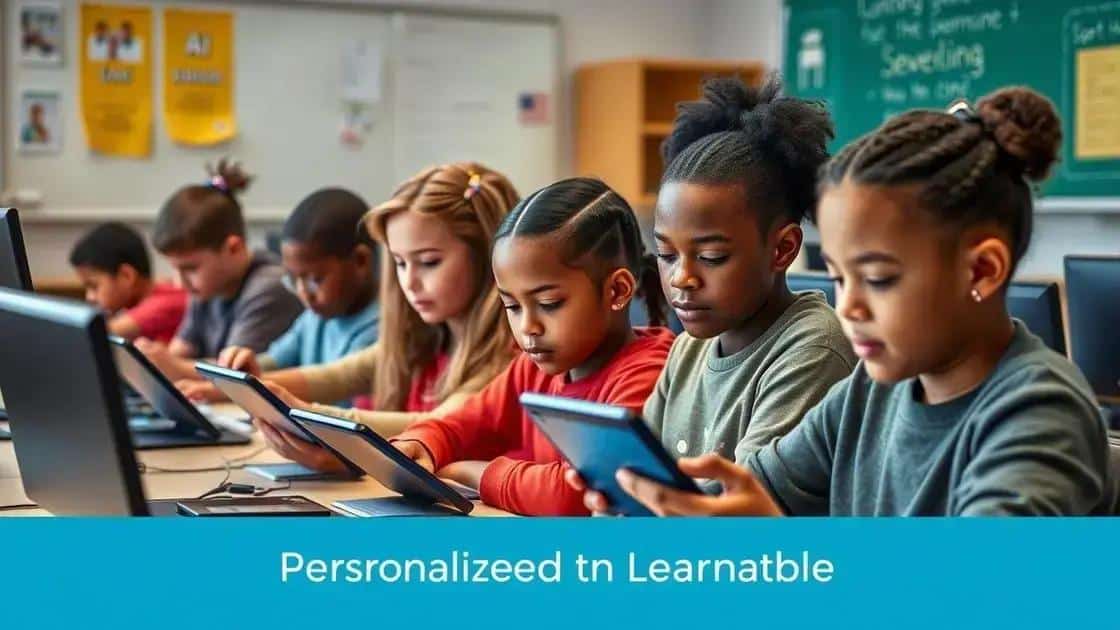AI in classrooms trends: how technology is reshaping education

AI in classrooms enhances personalized learning by tailoring educational experiences to individual needs, utilizing data analysis for performance insights, and fostering collaboration among students through innovative technologies.
AI in classrooms trends are changing the way students learn and teachers teach. With innovative technologies emerging, have you considered how your education could benefit from these advancements?
Understanding AI in classrooms
Understanding AI in classrooms is crucial for grasping the future of education. This technology can personalize learning, making it more effective for students. Have you ever imagined how a classroom filled with smart technologies could transform learning experiences?
AI benefits can be immense. It helps teachers manage their time better and focuses more on teaching. Moreover, AI systems can adapt to students’ needs, making education more engaging.
Key Features of AI in Classrooms
Some key features that highlight the role of AI in education include:
- Personalized learning experiences
- Automated grading systems
- Data analytics for performance tracking
- Interactive learning tools
Furthermore, AI aids in identifying students who need additional support. Teachers can use these insights to tailor lessons effectively. As we embrace this technology, we’ll see a shift towards more interactive and adaptive educational environments.
The integration of AI tools in classrooms goes beyond just enhancing teaching methods. It fosters a culture of innovation where students learn to use smart technologies. This essential skill will prepare them for the future job market.
Challenges and Considerations
However, embracing AI in classrooms comes with its challenges. Issues like data privacy and access to technology must be addressed to create equitable learning environments. It’s vital for schools to have clear policies on technology use.
As AI technology evolves, its role in classrooms will also expand. Educators and institutions must adapt to new tools, ensuring they enhance the learning experience efficiently. The goal is to create a balance where technology supports education without overshadowing traditional methods.
How AI enhances personalized learning

AI enhances personalized learning by tailoring educational experiences to meet each student’s needs. Imagine a classroom where every student receives support that matches their learning style.
This technology uses data to assess how students learn best. By analyzing individual performance, AI can create customized lesson plans. This approach helps students grasp difficult concepts faster.
Benefits of Personalized Learning with AI
There are several key benefits to using AI for personalized learning:
- Adaptable lesson plans that adjust to student progress.
- Immediate feedback that helps students improve.
- Targeted resources for students who need extra help.
- Engaging activities that keep students motivated.
Furthermore, AI tools enable educators to focus on the unique needs of each student. For example, a reading app might adjust its difficulty based on a student’s reading level.
Students enjoy learning more when content is relevant and interesting. AI ensures students are engaged by offering options that cater to their preferences. As they make choices, they learn to take ownership of their education.
Creating a Supportive Learning Environment
In addition to individual support, AI fosters collaboration among students. It can identify groups of learners who share similar challenges. This allows teachers to organize group activities that enhance peer learning.
As AI continues to evolve, so do its capabilities in the classroom. Future advancements will likely bring even more interactive and engaging learning experiences. Keeping pace with these changes is essential for both educators and students.
Trends in classroom technology
Trends in classroom technology are shaping the future of education in significant ways. With the rise of digital tools, learning environments are becoming more interactive and engaging for students.
One exciting trend is the use of virtual reality (VR) in learning. VR can transport students to different worlds, making history lessons come alive or allowing them to explore the human body in 3D. This immersive experience enhances understanding and retention.
Popular Technologies in Today’s Classrooms
Several technologies are gaining traction in education:
- Smartboards that make lessons interactive and fun.
- Adaptive learning software that changes to meet student needs.
- Cloud computing for easy access to resources and collaboration.
- Mobile apps to support learning on-the-go.
Additionally, artificial intelligence is playing a crucial role in optimizing classroom experiences. AI tools help teachers identify learning gaps and recommend resources tailored to each student’s needs. This kind of support leads to improved educational outcomes.
The trend towards online learning platforms is also noteworthy. These platforms provide students with the flexibility to learn at their own pace. Material can be accessed anytime, making education more accessible.
Collaboration and Communication Tools
Another significant trend is the rise of communication apps that enhance collaboration among students and teachers. These tools facilitate discussions and project work, no matter where participants are located. Strong communication is vital for effective learning, and these technologies bridge that gap.
As classroom technology continues to evolve, it is likely to foster even more innovation. Schools that keep abreast of these trends can provide their students with the skills they need to succeed in a digital world.
The future of AI in education

The future of AI in education holds immense potential for transforming how students learn and interact in classrooms. As technology advances, we can expect AI to play an increasing role in educational settings, creating more personalized and engaging experiences for learners.
One exciting development is the rise of predictive analytics. This technology can analyze student data to forecast performance and identify potential challenges. Educators will be able to intervene early, providing support tailored to individual student needs.
Emerging AI Technologies in Classrooms
Several emerging technologies are set to shape the future of education:
- Intelligent tutoring systems that provide real-time feedback and guidance.
- Natural language processing tools to assist in writing and language learning.
- Virtual reality experiences that immerse students in interactive learning environments.
- AI-driven platforms that adapt content to student learning styles.
Furthermore, AI collaboration tools will facilitate teamwork amongst students, allowing them to work on group projects seamlessly, regardless of their physical location. This level of collaboration fosters a sense of community and connection in the learning process.
Teachers will also benefit from AI by having access to tools that help them plan lessons more efficiently and assess student performance more accurately. By automating routine tasks, teachers will have more time to focus on what they do best: teaching.
Ethics and Challenges Ahead
While the future is promising, challenges remain. Issues of data privacy and ethical use of AI technologies will become increasingly important. Schools must ensure that data is handled safely and that AI systems promote equity in education.
The integration of AI in education is not just about technology—it’s about enhancing the human experience in learning. As we move forward, the goal should be to use AI as a tool to empower students and educators alike, fostering environments where everyone can thrive.
FAQ – Frequently Asked Questions about AI in Education
How does AI enhance personalized learning?
AI tailors educational experiences to meet each student’s individual needs, making learning more effective.
What role does data analysis play in education?
Data analysis helps educators understand student performance, allowing for timely interventions and improved teaching strategies.
What are the benefits of using AI collaboration tools?
AI collaboration tools facilitate teamwork among students, making it easier to work on group projects regardless of location.
What ethical considerations are important when using AI in education?
Ensuring data privacy and responsible use of AI technologies is crucial to protect students and maintain trust.





